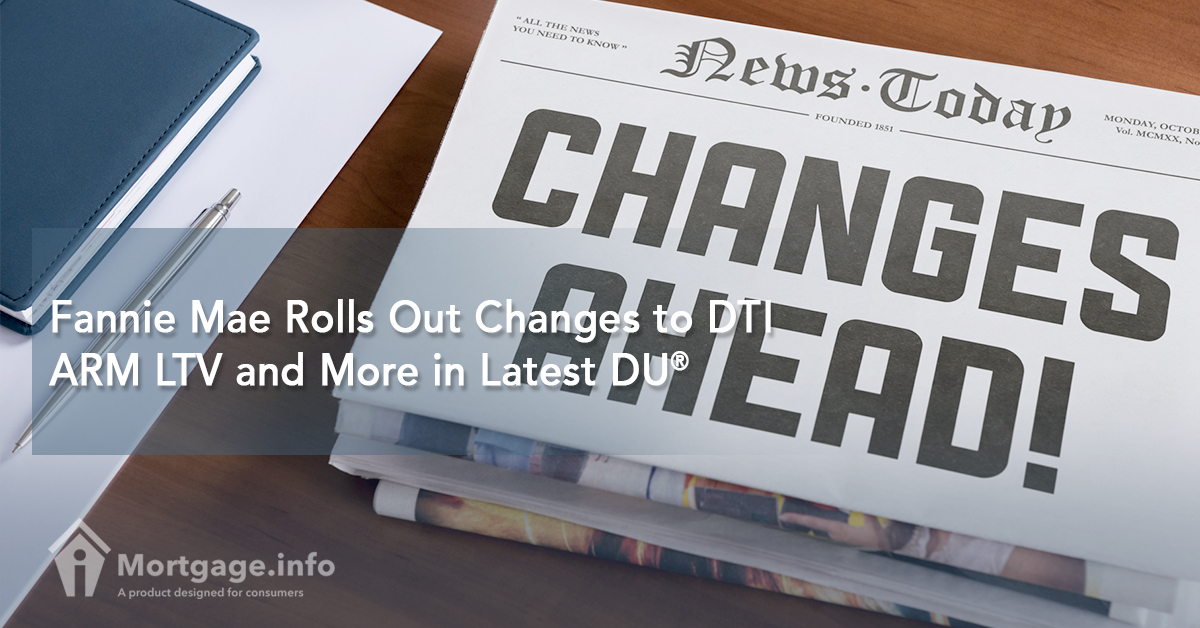Late May, Fannie Mae announced changes to its automated tool used by lenders to assess mortgage applications called the Desktop Underwriter®. Fannie Mae’s DU® 10.1 will contain an update to its risk assessment and incorporate a higher maximum allowable debt-to-income ratio, among other changes. Version 10.1 will be rolled out in the weekend of July 29.
Fannie Mae expects that the new credit risk assessment will increase the share of transactions that will receive an Approve/Eligible recommendation from DU®.
Main Changes Under Newest DU®
Desktop Underwriter® presents a new way of assessing credit risk of mortgage applications based on the following updated eligibility requirements and corresponding messages generated by DU®:
DTI: Lenders will now be able to consider applications with a maximum DTI ratio of 50%. Those with DTIs higher than 45% but up to 50% will not be required to present certain other compensating factors. If an application has a DTI exceeding the maximum allowable ratio of 50%, DU will issue an Ineligible recommendation.
Disputed Tradelines: Version 10.1 reflects a new way to assess tradelines in dispute. For example, a loan application with a disputed tradeline that received an Approve recommendation from DU® will not be required to submit further documentation on the said disputed tradeline. An application with a disputed tradeline that got an Ineligible recommendation from DU® can still be re-assessed without the tradeline in dispute. Depending on the determination of the lender on whether the disputed tradeline belongs to the borrower and he/she is responsible for it, the lender may manually underwrite the loan.
ARM LTV Ratios: DU® 10.1 will align the following ratios of an adjustable-rate mortgage with that of a fixed-rate mortgage: (a) LTV or loan-to-value, (b) CLTV or combined loan-to-value, and (c) HCLTV or home equity combined loan-to-value, of up to 95%.
Self-Employment Income: The 10.1 version has an updated documentation requirement to verify self-employment income. It is expected that more could qualify for one year’s worth of personal and business tax documents required by DU®.
Income and Employment: A lender is now able to validate income and employment from a borrower with a (i) self-employment income to be validated by tax transcripts, and (ii) base, bonus, overtime, and/or commission income to be validated by an income report. If the borrower submitted neither documents, the DU® will issue a message stating that his her income and employment can’t be validated. Notably, when employment is not validated by the DU®, then the income from an employer may not be validated.
Property Inspection Waiver: Under the version 10.1, PIW for Desktop Originator® loan applications that were previously underwritten with a sponsoring lender back in Dec. 2016 will be eligible for the PIW offer.
Changes Aligning with Fannie Mae’s Selling Guide
The DU® is used by lenders to verify requirements submitted by prospective borrowers of mortgages to be delivered to Fannie Mae using its guidelines issued to lenders, collectively the Selling Guide.
And the newest version of the Desktop Underwriter® contains updates in alignment with the applicable Selling Guide relating to:
- Student Loan Cash-out Refinance
- Employment Offer
- Multiple Financed Properties
- Site Condo References
- Treatment of Timeshares
- Homebuyer Education
To meet the CFPB’s policies, Version 10.1 will have data fields required by the Home Mortgage Disclosure Act (HMDA), as amended.
The rollout of DU® 10.1 is the retirement of Version 9.3. This means that lenders can’t resubmit loan applications to DU® 9.3 but they can view those loan applications under that version. For an updated DU® recommendation after July 29, lenders must create a new loan casefile with Version 10.1.

